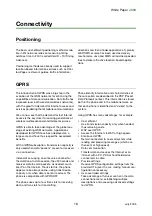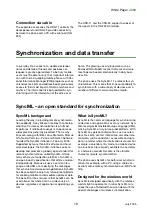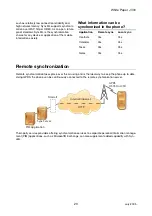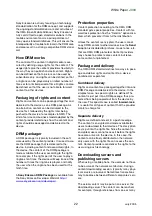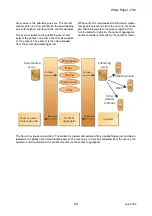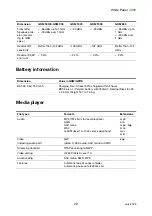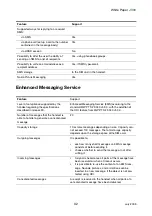
White Paper
J300
22
July 2005
Sony Ericsson is actively focusing on technology
standardization for the DRM concept, and supports
the ongoing standardization work and activities of
the OMA (Open Mobile Alliance). Sony Ericsson is
fully committed to open standard solutions in the
mobile environment and is a principal driver of
many open standard initiatives. This will ensure the
interoperability of mobile terminals in the DRM area
and also result in a strong, competitive DRM stand-
ard.
How DRM works
The control of the content in digital media is exe-
cuted by defining usage rights for the content. The
usage rights give the content providers flexibility in
the way they can publish and sell content. Rights
can be defined so that a picture can be used by
subscribers only, and rights can be defined so that
a ringtone can be played only a limited number of
times or for a limited period of time. Rights can also
be defined so that the user is not able to forward
content to other devices.
Packaging of rights and content
Rights and content can be packaged together and
delivered to the device as one DRM package. As
an alternative, content can be delivered to the
device first, followed by the rights later being
pushed to the device, for example via SMS. The
kind of service and business model adopted by the
content provider determines how the content and
rights should be packaged and delivered to the
device.
DRM packager
A DRM packager is typically included in the soft-
ware used by the content provider. It is used to cre-
ate the DRM package that is delivered to the
device, including content and associated rights. In
the device, the content of the DRM package is
made available to the user according to the rights.
For example, if the rights permit the user to play a
ringtone ten times, the device will keep track of the
number of times the ringtone is played, and notify
the user when the ringtone has been used for the
tenth time.
A
Sony Ericsson DRM Packager
is available from
the Sony Ericsson Developer World at
www.sonyericsson.com/developer/
.
Protection properties
Content protection according to the OMA DRM
standard gets special properties. Content with for-
ward lock protection has the “Send to” option disa-
bled, which prevents it from further distribution.
Unless the content is encrypted, the user cannot
copy DRM content to other devices since the
Send
to
option is disabled for pictures, music tones, etc.
that are OMA DRM protected. Content providers
may choose to protect some content, but leave
some content unprotected.
Package and delivery
The OMA DRM standard defines two ways to pack-
age and deliver rights and content to a device:
combined or separated.
Combined delivery
Rights and content are packaged together into one
DRM Package and delivered to the device. In the
simplest case, no special rights are defined. The
content is just put into a DRM package, thus pro-
tected from being copied out from the device by
the user. This special case is called
forward-lock
.
It is useful for all types of content that the provider
wants to charge for.
Separate delivery
Rights are defined and sent in a push message.
The content is encrypted and made available for
users to download to their devices. The decryption
key is put into the rights file. Since the content is
encrypted, users cannot access it before the rights
have also arrived in the device. In this case, the
content can be freely distributed on the network,
only users with the rights file can access the con-
tent. Content providers can deliver the rights to the
user using push technology.
Downloading servers and
publishing servers
When using a mobile phone, the users do not have
to be aware of the network architecture. During a
content downloading session, typically many phys-
ical servers are involved. Sometimes transactions
may take place between different companies’ serv-
ers.
The actual content may be put on one server, the
downloading server. The content can be reached,
for example, through references from one or many











